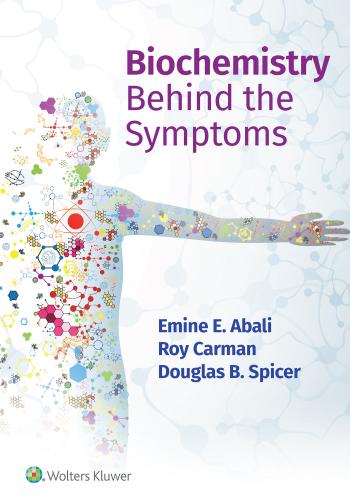Biochemistry Behind The Symptoms
| Item Information | |
|---|---|
| Item#: | 9781975191474 |
| Edition | 01 |
| Author | Carman & Spicer |
Biochemistry Behind the Symptomstakes a problem-based approach to understanding and applying biochemistry for superior clinical outcomes. Organized around the common symptoms encountered by clinicians, this engaging text clarifies the connections between foundational science and clinical manifestations to help users form confident diagnoses throughout their clerkship and beyond.
Each chapter explores the biochemical concepts behind underlying causes and demonstrates their ties to presenting symptoms through 5 realistic patient cases. Accompanying questions encourage discussion and guide users in building accurate differential diagnoses. Ideal for peer-to-peer learning environments or independent study, this practical approach strengthens users' application of fundamental knowledge and ensures the long-term retention essential to clinical success.50Patient Casesemphasize the biochemical concepts behind common patient symptoms through problem-based learning.Clinical Impressionsections encourage critical thinking and train students step by step in building effective differential diagnoses.Basic Science Correlationsin eachPatient Caseclarify the biochemical concepts underlying diagnosis with an engaging question-and-answer format.High-Yield Conceptssummarized after eachPatient Casereinforce students' comprehension of essential chapter concepts.Digital Animationsimmerse students in biochemical processes to enrich their understanding and diagnostic confidence.
Each chapter explores the biochemical concepts behind underlying causes and demonstrates their ties to presenting symptoms through 5 realistic patient cases. Accompanying questions encourage discussion and guide users in building accurate differential diagnoses. Ideal for peer-to-peer learning environments or independent study, this practical approach strengthens users' application of fundamental knowledge and ensures the long-term retention essential to clinical success.50Patient Casesemphasize the biochemical concepts behind common patient symptoms through problem-based learning.Clinical Impressionsections encourage critical thinking and train students step by step in building effective differential diagnoses.Basic Science Correlationsin eachPatient Caseclarify the biochemical concepts underlying diagnosis with an engaging question-and-answer format.High-Yield Conceptssummarized after eachPatient Casereinforce students' comprehension of essential chapter concepts.Digital Animationsimmerse students in biochemical processes to enrich their understanding and diagnostic confidence.
Short Description
Biochemistry Behind the Symptomstakes a problem-based approach to understanding and applying biochemistry for superior clinical outcomes. Organized around the common symptoms encountered by clinicians, this engaging text clarifies the connections between foundational science and clinical manifestations to help users form confident diagnoses throughout their clerkship and beyond.
Each chapter explores the biochemical concepts behind underlying causes and demonstrates their ties to presenting symptoms through 5 realistic patient cases. Accompanying questions encourage discussion and guide users in building accurate differential diagnoses. Ideal for peer-to-peer learning environments or independent study, this practical approach strengthens users' application of fundamental knowledge and ensures the long-term retention essential to clinical success.
Each chapter explores the biochemical concepts behind underlying causes and demonstrates their ties to presenting symptoms through 5 realistic patient cases. Accompanying questions encourage discussion and guide users in building accurate differential diagnoses. Ideal for peer-to-peer learning environments or independent study, this practical approach strengthens users' application of fundamental knowledge and ensures the long-term retention essential to clinical success.

